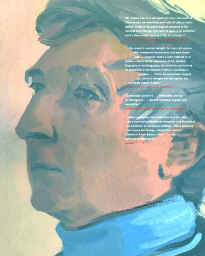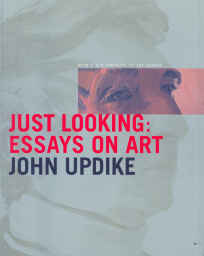

Just Looking
by
John Updike
Essays on Art
Published by Museum of Fine Arts/Boston in 2001
A Book Review by Bobby Matherne ©2004
Like Us? Subscribe to Receive a Monthly Email
Reminder of New Reviews & New DIGESTWORLD Issues — CLICK
~^~
I found it hard to resist a book whose first chapter is, "What MoMA Done Tole Me". MoMA is the Museum of Modern Art in New York and its affectionate name in the title evokes the refrain from the classic song, "Blues in the Night," which goes like this, "My momma done tole me, a man is a two-face, a troublesome thing that leads you to sing the blues in the night." Well, modern art, as Updike describes it, has two-faces: the beautiful and the ugly, the sacred and the profane. Modern art is a troublesome thing. If you have enough face-time with it, it will lead you to sing the blues in the night also.
In these collected essays, Updike shares with us his love affair with this fickle female called modern art, and like a young man in love, he has a collection of photographs of his beloved to show us as he describes her to us. This glossy, high-quality paperback, printed and bound in Italy, is filled with marvelous photographs, in color and black-and-white, so many pictures that each page has at least one photograph of an artwork talked about on that page and some pages are solely artwork images, no text. He discusses many more artworks than there are photographs in the book, but reading the book alongside an Internet connection, one can probably view the other images in real-time while reading the book via a Google-Images search.
Here is a sample of an artwork and his description. Apparently, like Shaw, Updike finds that quoting himself adds sparkle to his writing. See if you agree as he quotes from his own novel a description of the 'troublesome thing' and the 'blues in the night' it created in him.
[page 4, 5] This inventory excludes a larger statue on the second floor, who had already been given her sentences in a novel, The Centaur, from that same 1962: "In the center of the large oval room at the head of the stairs a naked green lady, life size, stood in the center of a circular black-lipped pool. She was a fountain. She held to her lips a scallop shell of bronze and her fine face was pursed to drink, but the mechanics of the fountain dictated that water should spill forever from the edge of the shell away from her lips. . . . As a child I was troubled by her imagined thirst, and I would place myself so I could see the enduring inch that held her mouth from contact with the water. . . . The patience of her wait, the mildness of its denial, seemed unbearable to me then, and I told myself that when darkness came, and the mummy and the Polynesian masks and the glass-eyed eagles below were sealed in shadow, then her slim bronze hand made the very little motion needed, and she drank."
It reminded me of the famous couplet by William Butler Yeats: "O body swayed to music, O brightening glance,/ How can we know the dancer from the dance?" In this case, how can we know the drinker from the drink? Or as Updike delineates in his essays, the artist from the artwork?
True "Lovers of Art" will read this book cover-to-cover then place it on a coffee table; pretenders to the title will look at a few pictures and place it on a coffee table. Who would prepare a fragrant and steaming cup of coffee and allow it to sit undrunk on a coffee table? This is a book on art by a writer — it behooves the buyer to be reading it, not just looking! Just looking may be enough for one who can see these things in Cezanne's painting "Pines and Rocks" that Updike calls to mind for us. We will each see different things, but a good writer on art will enable us to see things we could not have seen any other way than by reading his work. Updike achieves this time and time again in the essays assembled in this book.
[page 9, 11] The ardor of Cezanne's painting shone most clearly through this curiously quiet piece of landscape, which he might have chosen by setting his easel down almost anywhere. In this canvas, his numerous little decisions as to tone and color impart an excited shimmer to the areas where the green of the pines shows against the blue of the sky, to the parts of the ochre trunks where shadow and outline intermix, and to the foreground, rendered in parallel diagonal strokes, of earth and grass. Blue, green, and ochre - these basic shades never bore him, and are observed and captured each time as if afresh. In the intensity of the attention they receive, the painter's subjects shed their materiality: the pines' branches here and there leap free of the trunks, and the rocks have no heaviness, their planes all but dissolved in the rapid shift of grayish-blue tints. What did it mean, this oddly airy severity, this tremor in the face of the mundane? It meant that the world, even in such drab constituents as pines and rocks, was infinitely rewarding of observation, and that simplicity was composed of many little plenitudes, or small, firm arrivals --- paint pondered but then applied with a certain nervous speed. Cezanne's extreme concentration breaks through into a feeling as carefree and unencumbered as that which surrounds us in nature itself. In its new, minimal frame, Pines and Rocks seems smaller than the canvas I remember from the Fifties - but the grandeur of its silence, the gravity with which it seems to turn away from the viewer toward some horizon of contemplation, is undiminished.
A lot is made about how cheaply original works of art were sold by various artists in their own time. A van Gogh that went for 7 francs, for example. But who knows what else 7 francs could have bought in Vincent's time? Maybe a new suit of clothes? Updike tells us that some original Vermeers went from hand to hand for many years for the price of a suit. As I recall for the original works I have purchased recently that is still the case — they are still selling for the price of a suit of clothes during many artists' lifetimes.
[page 24] His sole bequest to his widow was between thirty and forty of his paintings. She struggled to save at least some of them from their creditors. Two were used to settle a baker's bill, and twenty-one were auctioned off in Amsterdam in 1696, and thence passed from owner to owner in the following centuries for less, ordinarily, than the price of a suit of clothes.
And would you be able to view the painting on page 50 of Catherine Vlasto, 1897, by John Singer Sargent, and have noticed the detail of what her right hand was doing, without Updike's pointing it out? I wasn't. Noticing that adds depth to our understanding of the woman and the dance that the artist was doing with her in his painting of her portrait.
[page 48] With equal daring, Catherine Vlasto's brow and eyes are left in shadow while the light falls on her neck and right side and the hand that oddly flattens several keys of the piano she leans against.
Updike closes with several samples of artworks by writers, including himself. In the next passage Updike quotes Joseph Conrad on the subject of art and writing.
[page 199] Joseph Conrad, introducing his third novel, the novel that committed him to the writer's vocation, made the visual component central: "Art itself may be defined as a single-minded attempt to render the highest kind of justice to the visible universe. . . . It is an attempt to find in its forms, in its colors, in its light, in its shadows, in the aspects of matter and in the facts of life, what of each is fundamental, what is enduring and essential. . . . My task which I am trying to achieve is, by the power of the written word, to make you hear, to make you feel — it is, before all, to make you see."
Reading how Updike also does artworks from time to time leads me to admit that I occasionally create artworks in the margins of books while reading. This book, with its wide margins and ample blank space at the top of each new essay, tempted the artist-me to fill the blank space with a thematic artwork of my date glyphes for 2004, a pair of love-birds. Incorporating my date glyph into an artwork is a curious way of signing an artwork. My date glyph is a small drawing which acts both as my signature and contains as an integral part the month, day, and year on which I read or wrote the material on the page upon which the glyph appears, thus, the name "date glyph", which was given to me by my friend, Ed Manning, many years ago(1). What makes the pieces below (and those on the various essays of the book) curious is that the artist's signature, my date glyph, is the artwork itself. See the three examples below.
Talking about Richard Diebenkorn's large abstract painting, Ocean Park No. 79, 1975, Updike has this to say.
[page 115] The painting in reality measures eight feet by seven. Our reproduction is eleven times smaller, and perhaps deceives us into pictorial speculations. Turning the pages of a book or magazine, we expect meaning; but in an actual environment, a museum or an opulent home, we settle for thereness.
Maybe that's what Updike's special gift is in this book of essays on art — he shares with us his meanings, but gives us in the process a sense of thereness. By all means, if you have a chance to visit the dozen or so museums that contain the works in his book and experience the works by being there, do so. Till then, this book is a ready substitute.
---------------------------- Footnotes -----------------------------------------
Footnote 1. I have since found that ‘date glyph’ is used to refer to figures carved in stone to represent a specific date on the Mayan Calendar.
Return to text directly before Footnote 1.
~~~~~~~~~~~~~~~~~~~~~~~~~~~~~~~~~~~~~~~~~~~~~~
~^~
Any questions about this review, Contact: Bobby Matherne
~~~~~~~~~~~~~~~~~~~~~~~~~~~~~~~~~~~~~~~~~~~~~~~~~~~~~~~~~~


22+ Million Good Readers have Liked Us
22,454,155 as of November 7, 2019
Mo-to-Date Daily Ave 5,528 Readers
For Monthly DIGESTWORLD Email Reminder:
Subscribe! You'll Like Us, Too!
== == == == == == == == == == == == == == == ==
Click Left Photo for List of All ARJ2 Reviews Click Right Bookcover for Next Review in List Did you Enjoy this Webpage?
Subscribe to the Good Mountain Press Digest: Click Here!


CLICK ON FLAGS TO OPEN OUR FIRST-AID KIT.
All the tools you need for a simple Speed Trace IN ONE PLACE.
Do you feel like you're swimming against a strong current in your life? Are you fearful? Are you seeing red? Very angry? Anxious? Feel down or upset by everyday occurrences? Plagued by chronic discomforts like migraine headaches? Have seasickness on cruises? Have butterflies when you get up to speak? Learn to use this simple 21st Century memory technique. Remove these unwanted physical body states, and even more, without surgery, drugs, or psychotherapy, and best of all: without charge to you.
Simply CLICK AND OPEN the
FIRST-AID KIT.

